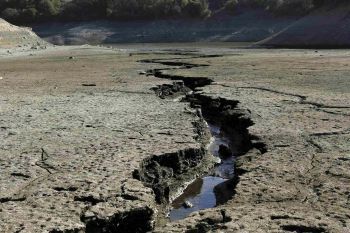
Publisher:
Bonnie King
CONTACT:
Newsroom@Salem-news.com
Advertising:
Adsales@Salem-news.com

~Truth~
~Justice~
~Peace~
TJP
Feb-20-2014 11:25

 TweetFollow @OregonNews
TweetFollow @OregonNews
Every State May Feel the Effects of Historic California Drought
Mark Leberfinger Special to Salem-News.comCalifornia Gov. Edmund G. Brown Jr. issued a drought State of Emergency in January.
 frontpagemag.com |
(STATE COLLEGE, PA AccuWeather.com) - AccuWeather.com report the historic California drought is far-reaching not only impacting the Golden State but also the rest of the United States.
In the last 500 years, there have been only three years as dry as the current one, B. Lynn Ingram, a paleoclimatologist at the University of California at Berkeley, said.
As a result of the drought, higher prices are possible for produce and other commodities, communities may run out of water and jobs may be lost, officials say.
Millions of dollars in federal disaster and other emergency assistance will be made available to California to deal with the drought, President Barack Obama announced last week.
Relief is also available for five drought-affected states, the president said.
A long-term ridge along the West Coast has pushed the jet stream much farther north than is usual this winter, creating the current conditions during the now-three-year-old drought, AccuWeather.com Western Weather Expert Ken Clark said.
"Already, there is talk of farmers having to leave fallow more than 1 million acres this year as there will not be the water to grow crops," Clark, who lives in California, said.
"Ranchers are selling herds as they will not be able to afford to feed livestock. Recreation with reservoirs being low are impacted, mandatory water restrictions may be needed and already Californians are being asked to conserve 20 percent of their normal water use."
There may be some rain in the next 10 to 14 days, but a major change won't soon be coming because of the extended nature of the drought, Clark said.
Since Dec. 1, Los Angeles has had only 6 percent of normal rain, Santa Maria 10 percent and San Luis Obispo and Paso Robles 19 percent of normal, Clark said.
California Gov. Edmund G. Brown Jr. issued a drought State of Emergency in January.
The California Department of Water Resources also announced that it is seeking to preserve remaining water supplies, so project customers will get no deliveries in 2014 if dry conditions persist.
The department also said that deliveries to agricultural districts with long-standing water rights in the Sacramento Valley may be cut 50 percent--the maximum permitted by contract--depending upon future snow survey results.
Water restrictions may cost California $11 billion in annual state revenue and affect 40 percent of Central Valley jobs that are tied to the agriculture industry, according to the California Farm Water Coalition, a nonprofit group representing a cross-section of the state's agricultural industry.
Paleoclimate studies show that multi-year droughts could last for decades to over a century, Ingram said. "However, these past droughts were not as dry as this year; they were around 30 to 40 percent drier," she said.
The other comparative droughts occurred in 1580, 1923-24 and 1976-77, Ingram said.
Ingram studies sediment cores taken from beneath lakes, estuaries (like San Francisco Bay) and the Pacific Ocean. The sediments have accumulated over the last several thousand years, and Ingram and her lab can look at the chemistry of the fossils in them to determine how climate has changed in the past.
Other climate researchers study width of tree growth rings, which reflects the amount of precipitation in the past.
Climate scientists see evidence that warming has been impacting California during the last 40 years, said Ingram, co-author of the book "The West Without Water: What Past Floods, Droughts, and Other Climatic Clues Tell Us About Tomorrow."
"Spring comes two weeks earlier, spring snowmelt is also earlier, and the snowpack has declined by 10 percent. Wildfire frequency has increased four-fold," she said.
"So there is a trend, but there is still natural variability in climate that has always been there (at least based on our paleoclimate studies, we see that climate in California and the west has been extremely variable over the past 20,000 years. We describe these studies in our new book "The West without Water"."
It doesn't feel different living in a drought area, although as a meteorologist, Clark said he is probably more aware of how serious the situation is than the average person.
"Therefore I feel the need to make sure I conserve where I can. I am on the board of our Homeowners Association and I am proposing this month major changes in our landscaping for our community of 545 homes to help save water and lower costs," he said.
Clark said he has been using less water than normal for his landscaping and making sure what he does use is being done right, such as sprinklers working properly.
"I'm also trying to take shorter showers and doing full loads of laundry and dishes," he said.
By Mark Leberfinger, Staff Writer AccuWeather.com
 |
 |
 |
Articles for February 19, 2014 | Articles for February 20, 2014 | Articles for February 21, 2014





Salem-News.com:
Terms of Service | Privacy Policy
All comments and messages are approved by people and self promotional links or unacceptable comments are denied.
Ralph E. Stone February 20, 2014 5:20 pm (Pacific time)
California has been the number one food and agricultural producer in the United States for more than 50 consecutive years. Because of the drought, consumers throughout the U.S. can expect higher food prices.
[Return to Top]©2025 Salem-News.com. All opinions expressed in this article are those of the author and do not necessarily reflect those of Salem-News.com.